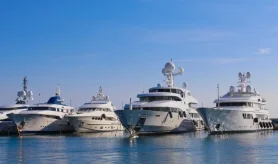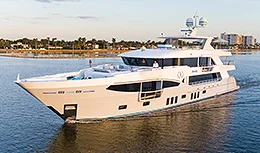- Alaskan Yachts
- Azimut Yachts
- Back Cove Yachts
- Beneteau Yachts
- Benetti Superyachts
- Bertram Yachts
- Boston Whaler
- Broward Yachts
- Buddy Davis Sportfish
- Burger Yachts
- Cabo Yachts
- Catamarans
- Carver Motoryachts
- Center Console
- Chris-Craft Yachts
- Cruisers Yachts
- DeFever Trawlers
- Dufour Sailboats
- Fairline Yachts
- Feadship Yachts
- Ferretti Yachts
- Filippetti Yachts
- Formula Yachts
- Fountaine Pajot Cats
- Grady-White
- Grand Banks Trawlers
- Hargrave Yachts
- Hatteras Yachts
- Hinckley Picnic Boats
- Horizon Yachts
- Hydra-Sports
- Intrepid Boats
- Jarrett Bay Sportfish
- Jeanneau Yachts
- Kadey-Krogen Trawlers
- Lazzara Yachts
- Lekker Boats
- Luhrs Sportfish
- Marlow Yachts
- Maritimo Yachts
- Marquis Yachts
- Mazu Yachts
- McKinna Motoryachts
- Meridian Yachts
- Midnight Express
- MJM Yachts
- Mochi Craft
- Neptunus Motoryachts
- Nordhavn Trawlers
- Nordic Tugs
- Numarine Yachts
- Ocean Alexander Yachts
- Ocean King
- Offshore Yachts
- Outer Reef
- Oyster Sailing Yachts
- Pacific Mariner Yachts
- Palmer Johnson Yachts

Wines of the World: Earthly Pleasures
For centuries, the best wines in the world have been made in vineyards by a mighty ocean and aged in châteaux by a meandering river. Creating microclimates in some areas and providing the much necessary humidity in others, water nourishes the art of winemaking.
This article was featured in the yachting magazine Numarine Insight.
Several years ago, I attended a conference in France on wine and spirits that was positively influential on my understanding of the relationship between wine and water. “Do you know what our most famous wine region is named after?” asked the elderly professor on the stage. Then he answered his own question: “The name of Médoc, where most ambitious French châteaux are located, comes from the combination of the words “Medio aquae,” which means “among the waters” in Latin. Indeed, these two regions stretch like an isthmus between the two waters, the Atlantic ocean and the Gironde estuary in the north of Bordeaux, and the wines originated here owe their perfection to this geography.”
“Many famous regions around the world owe the quality of their wines to a body of water, whether small or large.”
A group of wine writers, including myself, were listening to the head of the wine department at the giant amphitheater of the University of Bordeaux. The professor continued: “Bordeaux is a rather temperate-climate city located in southwestern France, closer to Spain. While Médoc, the most exclusive vineyard area, cools off with the winds blowing from the ocean to its left, to its right, the estuary, formed by the combination of the Garonne and Dordogne rivers, allows evaporation on hot days; thus increasing the humidity. The moisture nourishes the grapes and prevents them from maturing rapidly in the scorching heat. Therefore, grapes slowly grow and accumulate flavor, creating the castle wines that are sought after in those world-famous auctions.”
To be honest, I never really thought about the relationship between the seas, the rivers and the wines until this conference. However, the professor was right. Not only Bordeaux but also many famous regions around the world owe the quality of their wines to a body of water, no matter how small or large.
WINE OF THE PORTS

Another signature wine is Porto. Evidently, “Porto” means port. Portugal’s famous high-alcoholic sweet wine is made on the banks of a particular river, and aged where the river flows into the sea. The serpentine Douro, which meanders from the north of Spain all the way across Portugal, offers a cool and humid climate for the surrounding vineyards. Sweet wines made from these grapes are taken downriver, to be stored in barrels in cellars in Vila Nova de Gaia, where the river meets the ocean.
Here, in the giant wine warehouses called “Lodge,” Porto wine is left to age for 10, 20, or 30 years. This particular beauty sleep in the reservoirs can sometimes take up to even 40 years.
Barrels, transported from the Douro River by sailing boat until the middle of the 20th century have been transported by train since the dam was built. Yet the citizens of Porto have not abandoned these lovely flat-bottom boats called “Barcos Rabelos,” and perpetuate the tradition by racing them along a few miles of the river once a year.
Make no mistake; Douro is not to be trifled with. The Spanish vineyards, where the river passes through its shores under the name of “Duero”, also owe this river a lot. That is why the winemakers in these two countries sharing the same riverbanks meet every year at joint events in the spirit of the river fraternity. Even the wines in Spain are called “Ribera del Duero,” which means Duero riverbank.
Speaking of rivers, one should not forget the Rhône or the spicy wines that originate here. The river descends towards the south of France, to the legendary vineyards of Hermitage where Côte-Rôtie and Crozes-Hermitage are located on the right and left slopes. Moreover, the “noble rot” that gives rise to notes of honey and apricot in Sauternes, the world’s most precious sweet white wine also known as the liquid gold of Bordeaux, is also caused by the exceptional microclimate of the river Ciron, which flows through the same vineyards.
TASTES FROM THE SEA

Another wine that the shores breathe life into is Manzanilla. It is a golden-colored wine, only to be sipped with tapered, stemless glasses, preferably in tapas bars on the southern coast of Spain in the Andalusian region. Although the region’s high-alcoholic fortified wine is called sherry, the Sanlucar de Barrameda variety of sherry made in vineyards close to the sea is known as Manzanilla. Manzanilla is conceived thanks to the microclimate created by the salty winds which blow over vineyards. That is why this particular wine is slightly salty, making it perfectly compatible with tapas. Just like Malvasia from the island of Lipari in Sicily, another type of wine that gets its distinct flavor from the sea winds.
Although Sicily’s sweet wines, called “passito”, are very famous, Lipari’s sweet wine made in the same way, from sundried grapes, has a special place in the hearts of wine lovers. Since sweetness is balanced with a slightly salty flavor, it does not overwhelm the palate like many sweet wines do. Another example would be Germany’s two most famous white wines, Rheingau and Mosel, which are born in the vineyards located on the slopes on both sides of the Rhine and Mosel rivers. Here, the humidity works in reverse; while calming the heat in Bordeaux, Portugal and Spain, it breaks the cold and prevents the frost in Germany.
Wine is not the only drink nurtured by salty or sweet waters and the microclimates they create. Even cognac, another French liquid jewel, owes a lot to one particular river. Giant warehouses, where millions of liters of cognac slowly age, are lined up on either banks of the Charente to create cognac. “The reason why this drink is so expensive is the evaporation of wine by up to two percent per year from the pores of the barrels. As the brandy ages, the loss increases; thus, the price rises. However, Charente’s moist climate reduces evaporation. Were it not for this river, it would not have been possible to age the brandy so much,” says one cognac maker.

Of course, these are not the only delights that the world’s seas and rivers bring to vineyards. However, there is no need to hark back too far in history when some saltwater was added to preserve wines in amphorae to understand this tricky relationship. The tradition of shipping wine from the port of Bordeaux to Northern Europe, which continued until the 1800s, provides a more recent example. As the captains of the wine-laden ships came out of the delta where the Gironde estuary reached the ocean, they sank a crate of wine in a dark place and left a buoy on it. Since each ship had its own colored float, no sailor would lay hands on another ship’s wine. When the ships returned to Bordeaux months later, the wines were removed from the sea. Bottles rested for months in the dark were opened and the safe return to the port was celebrated.
“Of course, these are not the only delights that the world’s seas and rivers bring to vineyards.”
Oh yes, shores and wines. Their shared history goes back a long way and the legend continues…
Interested in learning more about Numarine Yachts? Contact Alex G. Clarke, who is ready to answer any questions and start your journey to owning a new yacht.
Speak With a Superyacht Specialist:






